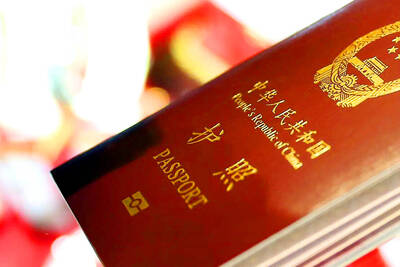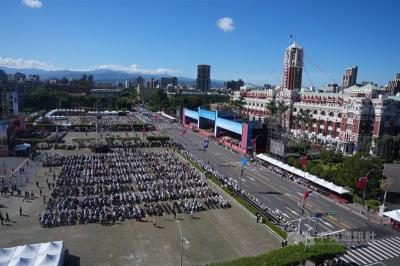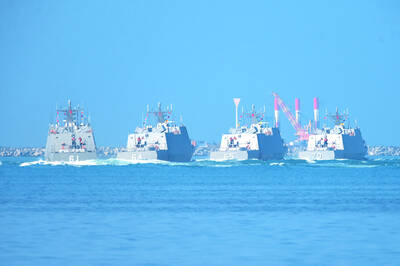Search crews have failed to relocate faint sounds heard deep in the Indian Ocean, possibly from the missing Malaysia Airlines jet’s black boxes whose batteries are at the end of their life.
Angus Houston, the retired Australian air chief marshal who is heading the search off western Australia, said listening equipment on the Ocean Shield has picked up no trace of the signals since they were first heard late on Saturday and early on Sunday. The signals had sparked hopes of a breakthrough in the search for Flight MH370.
Finding the black boxes quickly is critical, because their locator beacons have a battery life of only about a month — and yesterday marked exactly one month since the plane vanished. Once the beacons blink off, locating the black boxes in such deep water would be an immensely difficult, if not impossible, task.
“There have been no further contacts with any transmission and we need to continue [searching] for several days right up to the point at which there’s absolutely no doubt that the batteries will have expired,” Houston said.
If by that point the US Navy listening equipment being towed behind the Ocean Shield has failed to pick up any signals, a submarine will be deployed to try to chart out any debris on the seafloor. If the sub maps out a debris field, the crew will replace its sonar system with a camera unit to photograph any wreckage.
Earlier, Australian Acting Prime Minister Warren Truss had said the Bluefin 21 autonomous sub would be launched yesterday, but a spokesman for Truss said later the conflicting information was a misunderstanding and Truss acknowledged the sub was not being used immediately.
The two distinct sounds heard late on Saturday and early on Sunday are consistent with the pings from an aircraft’s black boxes, Houston said.
Australian Minister of Defense David Johnston called it the most positive lead and said it was being pursued vigorously. However, officials warned it could take days to determine whether the sounds were connected to the plane that vanished on March 8 on a flight from Kuala Lumpur to Beijing with 239 people on board.
“This is a Herculean task — it’s over a very, very wide area, the water is extremely deep,” Johnston said. “We have at least several days of intense action ahead of us.”
Houston said finding the sound again was critical to narrowing the search area before the sub can be used. If the vehicle went down now with the sparse data collected so far, it would take “many, many days” for it to cover all the places the pings might have come from.
“It’s literally crawling at the bottom of the ocean, so it’s going to take a long, long time,” Houston said.
He also warned of past false leads — such as ships detecting their own signals. Because of that, other ships are being kept away, so as not to add unwanted noise.
“We’re very hopeful we will find further evidence that will confirm the aircraft is in that location,” Houston said. “There’s still a little bit of doubt there, but I’m a lot more optimistic than I was one week ago.”
“Everyone’s anxious about the life of the batteries on the black box flight recorders,” Truss said. “Sometimes they go on for many, many weeks longer than they’re mandated to operate for — we hope that’ll be the case in this instance.”

The Ministry of the Interior (MOI) is to tighten rules for candidates running for public office, requiring them to declare that they do not hold a Chinese household registration or passport, and that they possess no other foreign citizenship. The requirement was set out in a draft amendment to the Enforcement Rules of the Public Officials Election and Recall Act (公職人員選舉罷免法 ) released by the ministry on Thursday. Under the proposal, candidates would need to make the declaration when submitting their registration forms, which would be published in the official election bulletin. The move follows the removal of several elected officials who were

The Republic of China (ROC) is celebrating its 114th Double Ten National Day today, featuring military parades and a variety of performances and speeches in front of the Presidential Office in Taipei. The Taiwan Taiko Association opened the celebrations with a 100-drummer performance, including young percussionists. As per tradition, an air force Mirage 2000 fighter jet flew over the Presidential Office as a part of the performance. The Honor Guards of the ROC and its marching band also heralded in a military parade. Students from Taichung's Shin Min High School then followed with a colorful performance using floral imagery to represent Taiwan's alternate name

FOUR DESIGNATED AREAS: Notices were issued for live-fire exercises in waters south and northwest of Penghu, northeast of Keelung and west of Kaohsiung, they said The military is planning three major annual exercises across the army, navy and air force this month, with the navy’s “Hai Chiang” (海強, “Sea Strong”) drills running from today through Thursday, the Ministry of National Defense said yesterday. The Hai Chiang exercise, which is to take place in waters surrounding Taiwan, would feature P-3C Orion maritime patrol aircraft and S-70C anti-submarine helicopters, the ministry said, adding that the drills aim to bolster the nation’s offshore defensive capabilities. China has intensified military and psychological pressure against Taiwan, repeatedly sending warplanes and vessels into areas near the nation’s air defense identification zone and across

A Chinese takeover of Taiwan would severely threaten the national security of the US, Japan, the Philippines and other nations, while global economic losses could reach US$10 trillion, National Security Council Deputy Secretary-General Lin Fei-fan (林飛帆) wrote in an article published yesterday in Foreign Affairs. “The future of Taiwan is not merely a regional concern; it is a test of whether the international order can withstand the pressure of authoritarian expansionism,” Lin wrote in the article titled “Taiwan’s Plan for Peace Through Strength — How Investments in Resilience Can Deter Beijing.” Chinese President Xi Jinping’s (習近平) intent to take Taiwan by force